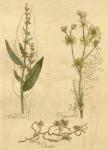A VERY pretty wild plant, with tufts of whitish flowers, and leaves finely divided. It grows two feet high. The stalk is round, striated, upright, firm, and branched. The leaves are large and divided into a great number of firm segments, they rise principally from the root, and stand on slender foot-stalks. There are few leaves on the stalks, and they are small. The flowers are little, but they stand in great tufts at the tops of the branches: they are white on the inside, and often reddish on the outside. The seeds are flattish and grow several together. The root is composed of a great number of small lumps, fastened together by filament. This root is the part most used; it is good in fits of the gravel, for it promotes urine greatly and safely. For this purpose the juice should be given, or a strong decoction of the fresh root. When dried it may be given in powder to stop the whites and purgings, it is a gentle and safe astringent.
There are several other plants called in English dropworts, which are very different in their qualities, and one of them is poisonous in a terrible degree; this last is called hemlock dropwort; care must therefore be taken that the right kind is used, but this is sufficiently different from all the others. The flower is composed of six little leaves, and is full of yellow threads in the middle; the flowers of all the others are composed only of five leaves each. They are all umbelliferous plants, but this is not; the flowers grow in clusters, but not in umbels: they grow like those of the ulmaria or meadow sweet.


